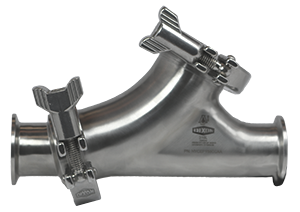
The primary function of any check valve is to prevent reverse flow. For example, in a car, fuel should flow from the gas tank to the engine, but not from the engine back to the gas tank, so a check valve is used. In sanitary applications, a Y-ball check valve provides a one-way seal, but there are important, often silent signs of valve instability that users should be aware of.
Y-ball check valve instability occurs when the ball inside the valve does not return smoothly to its seat. Instead, it can bounce, shift, or rock, which leads to noise, wear, leaks, and reduced performance. To better understand why instability happens, it helps to first look at how a Y-ball check valve is designed and how it operates.
How Does a Y-Ball Check Valve Work?
Inside the Y-shaped stainless steel body is a PTFE or elastomer ball to block reverse flow. Under forward pressure, the ball lifts off the seat and allows flow. When pressure drops or reverses, the ball returns to the seat and seals the system.
Where are Y-Ball Check Valves Used?
Y-ball check valves are used in processing lines for food and beverage, dairy, personal care, winery, brewery, pet product, and industrial markets.
Causes of Y-Ball Check Valve Instability
The ball in the valve is a moving part, and without proper guidance, it can move too much. In traditional designs, the ball relies on gravity and flow to return to its seat. In turbulent, pulsing, or vertical applications, the ball can bounce, shift, or even get wedged.
When the valve is in operation, a common misconception is that the ball can go all the way up into the wye to touch the end cap. Instead, the ball actually rests somewhere in between the wye and the inlet. In this position, the ball rocks back and forth constantly. If the ball material is a hard plastic, like PTFE which is used in Dixon’s HYC-series Y-ball check valve, the rocking will gradually wear the valve outlet body to form a pinhole where fluid can leak. If the ball is an elastomer, the rocking motion can cause wear on the ball and possibly rubber particles to break off into the process fluid. These undesirable situations lead to shorter valve lifespan and more frequent replacements.
Five Signs that a Y-Ball Check Valve is Unstable
- Rattling or clicking noises: Caused by the ball bouncing inside the valve during flow, often mistaken for normal system noise.
- Premature internal wear: Look for grooving or pitting inside the valve body; PTFE ball may show flattening or scarring.
- Backflow or inconsistent sealing: Ball doesn’t seat correctly every time, may lead to product leakage or CIP issues, leaks observed after pump shutdown or during CIP cycles.
- Unexpected ball position during maintenance: Ball sitting off center or wedged during disassembly indicates poor alignment or stabilization in the design.
- Ineffective air blow performance: Valve fails to purge properly.
How to Solve Y-Ball Check Valve Instability?
The best way to solve Y-ball check valve instability is to choose a valve with a stabilized design. Dixon’s redesigned HYC-series features a ball stabilizing end cap to prevent wear, rattle, and misalignment. The end cap keeps the ball in place during both product flow and air blow. In doing so, valve life is extended and system efficiency is improved.
Additionally, Dixon’s updated HYC-series Y-ball check valve features a more open body, providing improved flow and lower pressure drop, creating a more efficient system without requiring changes to existing setups. The valve retains the same face-to-face dimensions and inline configuration, making it a true drop-in replacement. Existing repair kits remain fully compatible with the updated design.


Dixon HYC-Series Y-Ball Check Valve
- 1-1/2” to 3”
Features
- Replaceable seat
- PTFE ball standard
- Vertical or horizontal installation orientation
- Improved flow performance and ball stabilization
Specifications
- Standard clamp connections
- Maximum pressure: 150 PSI (10 bar)
- Operating temperature: 15°F to 200°F (-9°C to 93°C)
- Product contact material components: CF8M (316)
- Non-product metal components: AISI 304
- Product contact seals: EPDM, FKM
- Ball: PTFE, EPDM, FKM, NBR
- Surface finish: Product contact metal components: Ra ≤ 32 standard
Summary
Y-ball check valve instability can lead to costly downtime, product leakage, and premature equipment wear if not properly addressed. By recognizing the key warning signs, processors can take steps to maintain efficiency and protect product integrity. Dixon’s HYC-series Y-ball check valve solves these issues with a stabilized ball design, improved flow characteristics, and drop-in compatibility with existing systems. This upgraded valve extends service life, reduces maintenance, and ensures reliable performance in demanding process environments.
For more information, visit dixonvalve.com or call 877.963.4966.



